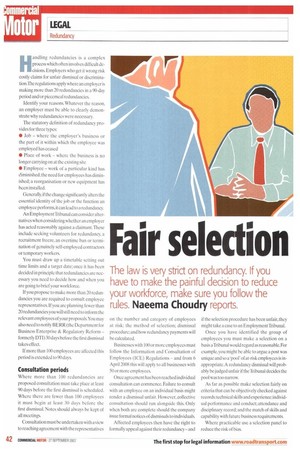Fair seledion
Page 42

Page 43

If you've noticed an error in this article please click here to report it so we can fix it.
The law is very strict on redundancy. If you have to make the painful decision to reduce your workforce, make sure you follow the
rules. Naeema Choudry reports. Handling redundancies is a complex process which often involves difficult decisions. Employers who get it wrong risk costly claims for unfair dismissal or discrimination:Me regulations apply where an employer is making more than 20 redundancies in a 90-day period and/or piecemeal redundancies.
Identify your reasons. Whatever the reason, an employer must be able to clearly demonstrate why redundancies were necessary.
The statutory definition of redundancy provides for three types: • Job — where the employer's business or the part of it within which the employee was employed has ceased • Place of work — where the business is no longer carrying on at the existing site • Employee — work of a particular kind has diminished; the need for employees has diminished; a reorganisation or new equipment has been installed.
Generally, if the change significantly alters the essential identity of the job or the function an employee performs, it can lead to a redundancy.
An Employment Tribunal can consider alternatives when considering whether an employer has acted reasonably against a claimant.'These include seeking volunteers for redundancy. a recruitment freeze, an overtime ban or termination of genuinely self-employed contractors or temporary workers.
You must draw up a timetable setting out time limits and a target date; once it has been decided in principle that redundancies are necessary you need to decide how and when you are going to brief your workforce.
If you propose to make more than 20 redundancies you are required to consult employee representatives. If you are planning fewer than 20 redundancies you will still need to inform the relevant employees of your proposals.You may also need to notify BERR (the Department for Business Enterprise & Regulatory Reform — formerly DTI) 30 days before the first dismissal takes effect.
If more than 1(X) employees are affected this period is extended to 90 days.
Consultation periods
Where more than IOU redundancies are proposed consultation must take place at least 90 days before the first dismissal is scheduled. Where there are fewer than 100 employees it must begin at least 30 days before the first dismissal. Notes should always be kept of all meetings.
Consultation must be undertaken with a view to reaching agreement with the representatives on the number and category of employees at risk; the method of selection; dismissal procedure; and how redundancy payments will be calculated.
Businesses with 100 or more employees must follow the Information and Consultation of Employees (ICE) Regulations — and from 6 April 2008 this will apply to all businesses with 50 or more employees.
Once agreement has been reached individual consultation can commence. Failure to consult with an employee on an individual basis might render a dismissal unfair. However, collective consultation should run alongside this. Only when both are complete should the company issue formal notices of dismissals to individuals.
Affected employees then have the right to formally appeal against their redundancy —and if the selection procedure has been unfair, they might take a case to an Employment Tribunal.
Once you have identified the group of employees you must make a selection on a basis a Tribunal would regard as reasonable.For example, you might be able to argue a post was unique and so a 'pool' of at-risk employees is inappropriate.A redundancy dismissal will probably be judged unfair if the Tribunal decides the pool was too narrow.
As far as possible make selection fairly on criteria that can be objectively checked against records: technical skills and experience:individual performance and conduct; attendance and disciplinary record; and the match of skills and capability with future business requirements.
Where practicable use a selection panel to reduce the risk of bias. An employee who unreasonably refuses an offer of suitable alternative employment risks losing the right to a redundancy payment. Note that where a woman is on maternity leave and a redundancy situation arises she must be offered any suitable alternative vacancies ahead of other staff.
Listen to comments Once the selection prmess has been carried out inform the employee of the proposal. Discuss the situation directly with the individual and listen to any comments that he or she might have regarding the selection process.
Confirm the decision in a final letter detailing all the meetings and discussions that have taken place. If the employee is to be made redundant state how the payment is to be calculated. • CONTACT BERR at www.berr.gov.uk
• Naeema Choudry is a Partner in the Human Resources Group of the national lawfirm Eversheds.


























































































































































































